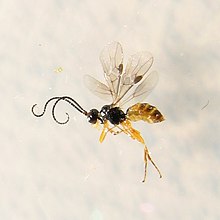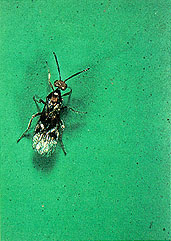en
names in breadcrumbs


Bracon is a genus of wasps in the Braconidae, a family of parasitoid wasps. There are several hundred described species but there are thousands still undescribed.[1] The genus is cosmopolitan, distributed throughout the world, with most of the described species occurring in the Palearctic realm.[1]
These wasps are mostly ectoparasitoids, with the larvae developing on the outside of the body of the host. Recorded hosts include the larvae of many species of lepidopterans, beetles, flies, hymenopterans, and true bugs.[1] They are idiobionts, halting the development of the host when they lay eggs on its body. Some Bracon wasps are specific to one host species, and some are known to utilize many different hosts.[2] The eggs of the wasp can be very hardy. In one report, Bracon wasps oviposited on tortrix moth larvae, which then entered privet seeds and were consumed by birds along with the fruit. The wasp eggs were later excreted and the larvae emerged.[3]
This large genus has been divided into several subgenera, some of which are further divided into species-groups.[4] A DNA analysis showed that the genus is paraphyletic, that its subgenera and other defined groups are not all valid on a molecular basis, and that revising it into informal groups would be more practical.[5] Other authors still divide the genus into subgenera using morphological characters to make identification easier.[6]
Most of the thousands of species that fit into this genus have not yet been described, but even the number of named species is unclear, with estimates ranging from 500[7] to 1000.[5]
Species include:[8]
 Bracon sp.
Bracon sp. Bracon is a genus of wasps in the Braconidae, a family of parasitoid wasps. There are several hundred described species but there are thousands still undescribed. The genus is cosmopolitan, distributed throughout the world, with most of the described species occurring in the Palearctic realm.
These wasps are mostly ectoparasitoids, with the larvae developing on the outside of the body of the host. Recorded hosts include the larvae of many species of lepidopterans, beetles, flies, hymenopterans, and true bugs. They are idiobionts, halting the development of the host when they lay eggs on its body. Some Bracon wasps are specific to one host species, and some are known to utilize many different hosts. The eggs of the wasp can be very hardy. In one report, Bracon wasps oviposited on tortrix moth larvae, which then entered privet seeds and were consumed by birds along with the fruit. The wasp eggs were later excreted and the larvae emerged.
This large genus has been divided into several subgenera, some of which are further divided into species-groups. A DNA analysis showed that the genus is paraphyletic, that its subgenera and other defined groups are not all valid on a molecular basis, and that revising it into informal groups would be more practical. Other authors still divide the genus into subgenera using morphological characters to make identification easier.
Most of the thousands of species that fit into this genus have not yet been described, but even the number of named species is unclear, with estimates ranging from 500 to 1000.
Species include:
 Bracon hebetor Bracon acrobasidis Bracon agathymi Bracon americanus Bracon analcidis Bracon angelesius Bracon apicatus Bracon argutator Bracon bembeciae Bracon brachyurus Bracon brevicornis Bracon canadensis Bracon caulicola Bracon cephi Bracon cinctus Bracon connecticutorum Bracon cuscutae Bracon cushmani Bracon erucarum Bracon furtivus Bracon gastroideae Bracon gelechiae Bracon gemmaecola Bracon geraei Bracon gossypii Bracon gracilis Bracon hebetor Bracon helianthi Bracon hemimenae Bracon hobomok Bracon hyslopi Bracon jani Bracon kirkpatricki Bracon konkapoti Bracon laemosacci Bracon lineatellae Bracon lissogaster Bracon lutus Bracon mellitor Bracon metacomet Bracon minutator Bracon montowesi Bracon nanus Bracon nevadensis Bracon niger Bracon nuperus Bracon oenotherae Bracon palliventris Bracon papaipemae Bracon pascuensis Bracon piceiceps Bracon piger Bracon pini Bracon podunkorum Bracon predatorius Ranjith & Quicke, 2022 Bracon quinnipiacorum Bracon radicis Bracon rhyssomati Bracon rosaceani Bracon rufomarginatus Bracon sanninoideae Bracon scanticorum Bracon sesiae Bracon sphenophori Bracon sulcifrons Bracon tachypteri Bracon tenuiceps Bracon tenuis Bracon terebella Bracon tychii Bracon uncas Bracon variabilis Bracon vulgaris Bracon wawequa Bracon xanthonotus
Bracon hebetor Bracon acrobasidis Bracon agathymi Bracon americanus Bracon analcidis Bracon angelesius Bracon apicatus Bracon argutator Bracon bembeciae Bracon brachyurus Bracon brevicornis Bracon canadensis Bracon caulicola Bracon cephi Bracon cinctus Bracon connecticutorum Bracon cuscutae Bracon cushmani Bracon erucarum Bracon furtivus Bracon gastroideae Bracon gelechiae Bracon gemmaecola Bracon geraei Bracon gossypii Bracon gracilis Bracon hebetor Bracon helianthi Bracon hemimenae Bracon hobomok Bracon hyslopi Bracon jani Bracon kirkpatricki Bracon konkapoti Bracon laemosacci Bracon lineatellae Bracon lissogaster Bracon lutus Bracon mellitor Bracon metacomet Bracon minutator Bracon montowesi Bracon nanus Bracon nevadensis Bracon niger Bracon nuperus Bracon oenotherae Bracon palliventris Bracon papaipemae Bracon pascuensis Bracon piceiceps Bracon piger Bracon pini Bracon podunkorum Bracon predatorius Ranjith & Quicke, 2022 Bracon quinnipiacorum Bracon radicis Bracon rhyssomati Bracon rosaceani Bracon rufomarginatus Bracon sanninoideae Bracon scanticorum Bracon sesiae Bracon sphenophori Bracon sulcifrons Bracon tachypteri Bracon tenuiceps Bracon tenuis Bracon terebella Bracon tychii Bracon uncas Bracon variabilis Bracon vulgaris Bracon wawequa Bracon xanthonotus
Bracon es un género de avispas parasitoides de la familia Braconidae.[3] Hay varios centenares de especies descritas y posiblemente miles aun sin describir.[4] El género es cosmopolita con la mayoría de las especies descritas encontradas en el Paleártico.[4]
Son ectoparasitoides, es decir que las larvas se desarrollan fuera del cuerpo del huésped. Entre las especies huéspedes se cuentan lepidópteros, escarabajos, moscas, himenópteros y hemípteros.[4] Son idiobiontes. Detienen el desarrollo del huésped cuando depositan los huevos en su cuerpo. Algunas especies son especialistas en una sola especie de huésped y otras usan muchas especies diferentes.[5]
Los huevos de estas avispas pueden ser sumamente resistentes. Hay un informe de huevos de Bracon depositados en una polilla tortrícida que después penetró una semilla de ligustro, la cual fue tragada por un ave. Después la semilla fue excretada por el pájaro y la avispa completó su ciclo biológico y emergió.[6]
Este numeroso género ha sido subdividido en varios subgéneros, los cuales a su vez se dividen en grupos de especies.[7] El anállisis de ADN indica que el grupo es parafilético y que sus subgéneros y grupos no todos tienen una base molecular válida. Es necesario reanalizar el grupo entero.[8] Otros autores continúan dividiento el género en subgéneros en base a caracteres morfológicos para facilitar la identificación.[9]
La mayoría de los miles de especies que aun se encuadran en este género siguen sin estar descritas, pero aun aquellas que han sido descritas presentan problemas en su clasificación. Incluso sus números son dudosos, calculándose alrededor de 500[10] a 1000.[8]
Bracon es un género de avispas parasitoides de la familia Braconidae. Hay varios centenares de especies descritas y posiblemente miles aun sin describir. El género es cosmopolita con la mayoría de las especies descritas encontradas en el Paleártico.
Son ectoparasitoides, es decir que las larvas se desarrollan fuera del cuerpo del huésped. Entre las especies huéspedes se cuentan lepidópteros, escarabajos, moscas, himenópteros y hemípteros. Son idiobiontes. Detienen el desarrollo del huésped cuando depositan los huevos en su cuerpo. Algunas especies son especialistas en una sola especie de huésped y otras usan muchas especies diferentes.
Los huevos de estas avispas pueden ser sumamente resistentes. Hay un informe de huevos de Bracon depositados en una polilla tortrícida que después penetró una semilla de ligustro, la cual fue tragada por un ave. Después la semilla fue excretada por el pájaro y la avispa completó su ciclo biológico y emergió.
Este numeroso género ha sido subdividido en varios subgéneros, los cuales a su vez se dividen en grupos de especies. El anállisis de ADN indica que el grupo es parafilético y que sus subgéneros y grupos no todos tienen una base molecular válida. Es necesario reanalizar el grupo entero. Otros autores continúan dividiento el género en subgéneros en base a caracteres morfológicos para facilitar la identificación.
La mayoría de los miles de especies que aun se encuadran en este género siguen sin estar descritas, pero aun aquellas que han sido descritas presentan problemas en su clasificación. Incluso sus números son dudosos, calculándose alrededor de 500 a 1000.
Algunas especiesBracon est un genre d'insectes de l'ordre des hyménoptères de la famille des Braconidae, de la sous-famille des Braconinae et de la tribu des Braconini. C'est le genre type de sa famille.
Bracon est un genre d'insectes de l'ordre des hyménoptères de la famille des Braconidae, de la sous-famille des Braconinae et de la tribu des Braconini. C'est le genre type de sa famille.
Bracon is een geslacht van vliesvleugelige insecten (Hymenoptera) uit de familie van de schildwespen (Braconidae). De wetenschappelijke naam van het geslacht is voor het eerst geldig gepubliceerd door Johan Christian Fabricius in 1804.[1]
Bracon is een omvangrijk geslacht van parasitoïde wespen dat over de hele wereld voorkomt. Er zijn zo'n 250 soorten gekend in Europa en wereldwijd minstens 500, maar het aantal nog niet beschreven soorten ligt nog veel hoger.
De larven zijn meestal ectoparasitoïden, die zich ontwikkelen aan de buitenkant van hun gastheer (een larve van een insectensoort uit de orde Diptera, Coleoptera, Hymenoptera of Lepidoptera). Voordat ze haar eitjes erop legt, verlamt de wesp de gastheerlarve, waardoor de verdere ontwikkeling ervan wordt verhinderd. Sommige soorten hebben een specifieke gastheersoort maar er zijn ook Bracon-soorten zoals Bracon variator die vele verschillende gastheersoorten gebruiken.[2]
Een aantal soorten is onderzocht als potentiële biologische bestrijding van plaaginsecten. Bracon hylobii bijvoorbeeld is een natuurlijke vijand van de dennensnuitkever (Hylobius abietis) die schade aan naaldbomen kan aanrichten.[3] Een van de gastheersoorten van Bracon mellitor is de katoensnuitkever (Anthonomus grandis).[4] Bracon intercessor is een parasitoïde van de populierenwespvlinder Paranthrene tabaniformis.[5]
Bracon is een geslacht van vliesvleugelige insecten (Hymenoptera) uit de familie van de schildwespen (Braconidae). De wetenschappelijke naam van het geslacht is voor het eerst geldig gepubliceerd door Johan Christian Fabricius in 1804.
Bracon is een omvangrijk geslacht van parasitoïde wespen dat over de hele wereld voorkomt. Er zijn zo'n 250 soorten gekend in Europa en wereldwijd minstens 500, maar het aantal nog niet beschreven soorten ligt nog veel hoger.
De larven zijn meestal ectoparasitoïden, die zich ontwikkelen aan de buitenkant van hun gastheer (een larve van een insectensoort uit de orde Diptera, Coleoptera, Hymenoptera of Lepidoptera). Voordat ze haar eitjes erop legt, verlamt de wesp de gastheerlarve, waardoor de verdere ontwikkeling ervan wordt verhinderd. Sommige soorten hebben een specifieke gastheersoort maar er zijn ook Bracon-soorten zoals Bracon variator die vele verschillende gastheersoorten gebruiken.
Een aantal soorten is onderzocht als potentiële biologische bestrijding van plaaginsecten. Bracon hylobii bijvoorbeeld is een natuurlijke vijand van de dennensnuitkever (Hylobius abietis) die schade aan naaldbomen kan aanrichten. Een van de gastheersoorten van Bracon mellitor is de katoensnuitkever (Anthonomus grandis). Bracon intercessor is een parasitoïde van de populierenwespvlinder Paranthrene tabaniformis.
Bracon[1] är ett släkte av steklar som beskrevs av Fabricius 1804. Bracon ingår i familjen bracksteklar.[1][2]
Bracon är ett släkte av steklar som beskrevs av Fabricius 1804. Bracon ingår i familjen bracksteklar.
Bracon (лат.) — род паразитических наездников из семейства Braconidae. Встречаются повсеместно. Более 500 видов (до 1000)[1][2][3][4][5].
Длина 2-6 мм. Усики тонкие, нитевидые. Эктопаразиты личинок насекомых, главным образом, жуков, двукрылых, бабочек и перепончатокрылых. Крупнейший род подсемейства Braconinae и один из крупнейших в составе всего семейства бракониды [1][2][6].
Bracon (лат.) — род паразитических наездников из семейства Braconidae. Встречаются повсеместно. Более 500 видов (до 1000).